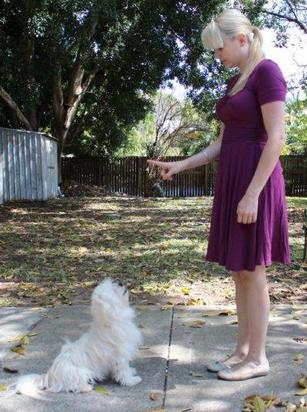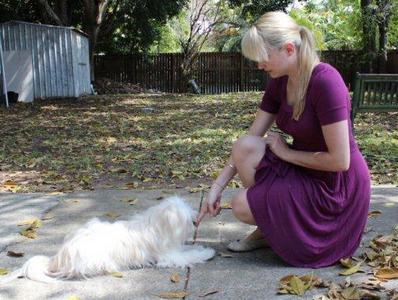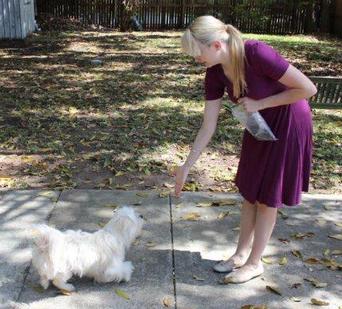Some Basic Obedience Commands (continued)
There are some rules to follow.
- Aim to make your dog respond with one command. Two is your absolute limit.
- Don’t machine gun a commands by repeating them over and over again trusting that your dog will eventually get your message. This only trains your dog to ignore your commands.
- If your dog has not responded by the first command, repeat the command again but this time gently place the dog in the correct position.
- By not proceeding to the third, forth or fifth command, you are setting a ‘brick wall’ limit to your dog’s non-response and showing it – gently – that you mean what you say.
- Use a firm voice for commands but a light voice, or sometimes a whisper, for praise. Minimise the ‘bad dog’ punishing voice

The “SIT” Command
Stand or kneel in front of your dog with a piece of liver treat or a similar food reward in your hand. Start with your hand at a low level and with your hand rising in a concave arc with your dog’s head at the centre point, give the command “SIT”. Raise you hand to a point above and behind your dog’s forehead in such a position that your dog has to arc its head backwards to look at the food. This encourages the dog’s bottom to sink to the ground.
At the same time, with your spare hand use your forefinger to gently tap your dog’s hind-quarters. This will encourage the dog to SIT. You should be doing this as the food in your other hand rises above its head. As your dog’s head goes up, its bottom automatically goes down into the SIT position. This makes everything much simpler.
When your dog is in the SIT position, wait for five seconds and THEN praise it (“GOOD DOG”) while holding the food just out of reach of its nose. (This fortifies the Sit position and leads to the STAY command – coming next), then give your dog the food reward.
The “STAY” Command
This is a natural progression from the previous command.
With your dog successfully in the “SIT” position, give it the “STAY” command.
The hand signal is the open hand, palm vertical and facing towards your dog’s nose, sweeping towards its face.
The hand command is easy to remember as with the palm vertical and open, it looks like a barrier or fence and probably acts that way for your dog too.
The “STAY” Command
This is a natural progression from the previous command.
With your dog successfully in the “SIT” position, give it the “STAY” command.
The hand signal is the open hand, palm vertical and facing towards your dog’s nose, sweeping towards its face.
The hand command is easy to remember as with the palm vertical and open, it looks like a barrier or fence and probably acts that way for your dog too.

The “DOWN” Command

The “DOWN” command is just as easy. Start with your dog in the SIT position.
State the command “DOWN” and (with food in hand) use a hand signal sweeping n an arc from its nose downwards and then along the floor for a short distance.
Your dog’s nose is likely to follow the food treat but you may like to fortify the correct ‘lying down’ action by pushing gently on your dog’s shoulders or by moving its front feet out while pushing on its shoulders.
The “Come” Command
This is usually most easily taught by having your dog on a lead at first. The goal is to
firstly get your dog to come on command when you are in the house and it then when it is anywhere in the garden.
The first step is to condition your dog to responding to the word COME and to make sure it really knows that you will give a delectable food reward when it does.
Start in your lounge-room. Have your dog on a lead. Place it in the SIT and STAY position. Show him or her that you have a food reward.
Give the command COME and use the hand signal described next but walk backwards a few steps while you lure if forward with the food.
The hand signal is made by moving both arms moving in an upward arc from waist level arcing towards your face, just as if you were calling someone to you from a distance. Do it slowly and deliberately.
Aid your dog’s approach by pulling on the rope. Make your dog SIT in front of you, wait five seconds with it focussed on the food, and then give it the food reward.
Now progress further by taking your dog into your garden but on a longer rope.
Eventually get to the stage that you have someone holding your dog at a far corner of the yard while you give the COME command from inside the house.
Make the whole routine like a game for your dog so that it enjoys the interaction.

Time-tabling
Take two weeks to teach these four commands. I suggest two to three sessions per day, five days per week. Keep each session to no more than five minutes but keep it exciting and make it fun for both of you.
The circle of commands described in the Getting Good Behaviour from Dogs sheet will help with this process.
Step 1 Some Basic Obedience Commands

